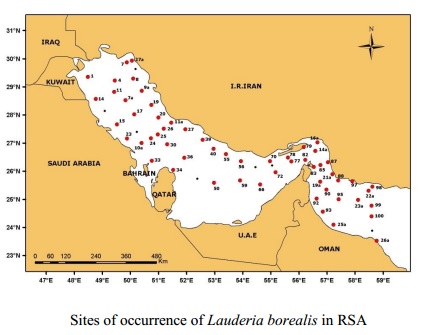Lauderia borealis Gran
 Division: Chromophyta
Division: Chromophyta
Class: Bacillariophyceae
Order: Biddulphiales
Suborder: Coscinodiscineae
Family: Thalassiosiraceae Lebour
Genus: Lauderia Cleve
Scientific name: Lauderia borealis Gran
Cells cylindrical. Valves rounded. Cells united in straight chains by very fine gelatinous threads, cells either touching or separated. An unpaired, oblique, outwardly directed apiculus on each valve, and numerous very small spinulae or slime canals at the margin and over most of the surface. Center of valve is slightly concave. Intercalary bands numerous; collarlike; more or less conspicuous. Chromatophores are numerous small plates. Nucleus more or less central, in a cytoplasmic cord which binds the central parts of the valves together. Although the cell wall is thin, it has a distinct structure. The valve surface is radially striated, the mantle surface of the intercalary bands delicately areolated (Cupp, 1943).

References:
Pavillard, 1925: p. 21, Fig. 32; Hustedt, 1930: p. 550, Fig. 313;Cupp, 1943: p. 74, Fig. 35; Hendey, 1964: p. 143; Ricard, 1987:p. 163, Fig. 147.
Description:
Cells in thick, straight chains, touching their valve surfaces.
Valves slightly concave in the center, rounded at the margins.
Marginal spinulae straight with gelatinous straight, radiating,longer or shorter threads, the longer reaching the adjacent cell. A
single unpaired spine, thicker and more robust than the others,occurs near the margin of the valve. Diameter of cells 28-47 µm.
Intercalary bands, as in general, the entire cell wall, are comparatively delicate, indistinct in water except in older cells or on older valve. Mantle surface delicately areolated-punctated, puncta in irregular rows. Intercalary bands with about 16 puncta in 10 µm, irregularly arranged. No resting spores known. Chromatophores are small, lobed, grouped at ends of cell in strong light (Cupp, 1943).
Dimensions:
Cells diameter 38-55 µm.
Distribution:
Neritic, temperate species.
Sites of occurrence in RSA:
In Winter 2006 Cruise, Lauderia borealis was commonly found in the RSA phytoplankton (refer sites map), often in significant abundance. It contributed up to 61 % of the total phytoplankton abundance; the highest concentration reached 3.4*10^5
cells/l. High abundance of Lauderia borealis (> 105cells/l) was observed in the Sea of Oman (Stations 97 and 25a).
Species has been previously reported from Kuwaiti waters of the inner RSA (Al-Yamani etal., 2004).

